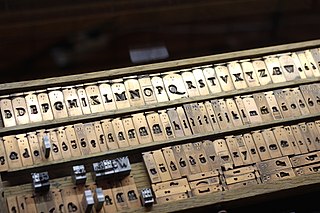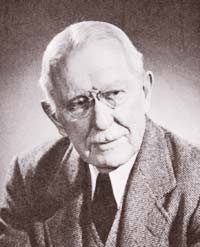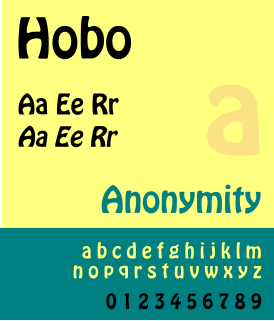
In the manufacture of metal type used in letterpress printing, a matrix is the mould used to cast a letter, known as a sort. Matrices for printing types were made of copper.

American Type Founders (ATF) was a business trust created in 1892 by the merger of 23 type foundries, representing about 85% of all type manufactured in the United States. The new company, consisting of a consolidation of firms from throughout the United States, was incorporated in New Jersey.

A type foundry is a company that designs or distributes typefaces. Before digital typography, type foundries manufactured and sold metal and wood typefaces for hand typesetting, and matrices for line-casting machines like the Linotype and Monotype, for letterpress printers. Today's digital type foundries accumulate and distribute typefaces created by type designers, who may either be freelancers operating their own independent foundry, or employed by a foundry. Type foundries may also provide custom type design services.

Punchcutting is a craft used in traditional typography to cut letter punches in steel as the first stage of making metal type. Steel punches in the shape of the letter would be used to stamp matrices into copper, which were locked into a mould shape to cast type. Cutting punches and casting type was the first step of traditional typesetting. The cutting of letter punches was a highly skilled craft requiring much patience and practice. Often the designer of the type would not be personally involved in the cutting.
Theo Rehak is a typefounder and the author of Practical Typecasting (ISBN 0-938768-33-6), The Fall of ATF; a Serio-Comedic Tragedy and co-author of The Music and Life of Theodore "Fats" Navarro" (ISBN 0-8108-6721-4). He is one of the few remaining craftsmen in the field of metal typefounding. Rehak was the last person trained at American Type Founders before their 1993 bankruptcy. He formed The Dale Guild Type Foundry in 1994, purchasing a significant portion of ATF equipment at the firm's liquidation auction. He is also an historian and has assisted museums, including The Smithsonian, around the world in creating exhibits and demonstrating printing technologies.

Goudy Old Style is an old-style serif typeface originally created by Frederic W. Goudy for American Type Founders (ATF) in 1915.

Bruce Rogers was an American typographer and type designer, acclaimed by some as among the greatest book designers of the twentieth century. Rogers was known for his "allusive" typography, rejecting modernism, seldom using asymmetrical arrangements, rarely using sans serif type faces, often favoring faces such as Bell, Caslon, his own Montaigne, a Jensonian precursor to his masterpiece of type design Centaur. His books can fetch high sums at auction.

Stephenson Blake is an engineering company based in Sheffield, England. The company was active from the early 19th century as a type founder, remaining until the 1990s as the last active type foundry in Britain, since when it has diversified into specialist engineering.
VEB Typoart was the only type foundry of East Germany. It was a state-owned enterprise located in Dresden. The foundry's most influential art directors were Herbert Thannhäuser and Albert Kapr.

Hobo is a sans-serif typeface. It is unusual in having virtually no straight lines and no descenders. It was created by Morris Fuller Benton and issued by American Type Founders in 1910. A light version, Light Hobo, was released in 1915. Matrices were offered for mechanical composition by Intertype. The lower case letters provided the basis for Robert Wiebking's Advertisers Gothic of 1917.
Sidney Clyde Gaunt was an American type designer and artist.
Barnhart Brothers & Spindler Type Foundry was founded as the Great Western Type Foundry in 1873. It became Barnhart Brothers & Spindler ten years later. It was a successful foundry known for innovative type design and well designed type catalogs. Oz Cooper, Will Ransom, Robert Wiebking, and Sidney Gaunt all designed for BB&S. It was bought out by American Type Founders in 1911 with the proviso that the merger would not take effect for twenty years, so that the employees would have a chance to find new work or retire over time. The foundry was finally closed in 1933.
Robert Wiebking (1870–1927) was a German-American engraver typeface designer who was known for cutting type matrices for Frederic Goudy from 1911 to 1926.

D. Stempel AG was a German typographic foundry founded by David Stempel (1869–1927), in Frankfurt am Main, Germany. Many important font designers worked for the Stempel foundry, including Hans Bohn, Warren Chappell, F. H. Ehmcke, Friedrich Heinrichsen, Hanns Th. Hoyer, F. W. Kleukens, Erich Meyer, Hans Möhring, Hiero Rhode, Wilhelm Schwerdtner, Herbert Thannhaeuser, Martin Wilke, Rudolf Wolf, Victor Hammer, Hermann Zapf, and Gudrun Zapf von Hesse. With the introduction of Memphis in 1929, the foundry was the first to cast modern slab serif typefaces.
Artcraft is an Old Style typeface engraved in 1912 by Robert Wiebking for Wiebking, Hardinge & Company which ran the Advance Type Foundry. It was originally called Craftsman, then Art-Craft, before finally becoming Artcraft. After Advance was sold to the Western Type Foundry in 1914, Wiebking added Artcraft Bold and Artcraft Italic. After Western was sold to Barnhart Brothers & Spindler the face was sold by both BB&S and ATF.
The Inland Type Foundry was an American type foundry established in 1894 in Saint Louis, Missouri and later with branch offices in Chicago and New York City. Although it was founded to compete directly with the "type trust", and was consistently profitable, it was eventually sold to ATF.

Bernard William "Berne" Nadal (1869–1932) was a typeface designer, among other things.
Peter A. Demeter was a German designer at the Weber Typefoundry.









